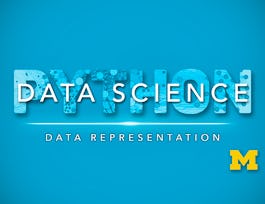This course will introduce the learner to network analysis through tutorials using the NetworkX library. The course begins with an understanding of what network analysis is and motivations for why we might model phenomena as networks. The second week introduces the concept of connectivity and network robustness. The third week will explore ways of measuring the importance or centrality of a node in a network. The final week will explore the evolution of networks over time and cover models of network generation and the link prediction problem.


Applied Social Network Analysis in Python
This course is part of Applied Data Science with Python Specialization
Taught in English
Some content may not be translated

Instructor: Daniel Romero
99,653 already enrolled
Included with 
Course
(2,684 reviews)
94%
What you'll learn
Represent and manipulate networked data using the NetworkX library
Analyze the connectivity of a network
Measure the importance or centrality of a node in a network
Predict the evolution of networks over time
Skills you'll gain
Details to know

Add to your LinkedIn profile
4 quizzes
Course
(2,684 reviews)
94%
See how employees at top companies are mastering in-demand skills

Build your subject-matter expertise
- Learn new concepts from industry experts
- Gain a foundational understanding of a subject or tool
- Develop job-relevant skills with hands-on projects
- Earn a shareable career certificate


Earn a career certificate
Add this credential to your LinkedIn profile, resume, or CV
Share it on social media and in your performance review

There are 4 modules in this course
Module One introduces you to different types of networks in the real world and why we study them. You'll learn about the basic elements of networks, as well as different types of networks. You'll also learn how to represent and manipulate networked data using the NetworkX library. The assignment will give you an opportunity to use NetworkX to analyze a networked dataset of employees in a small company.
What's included
5 videos3 readings1 quiz1 programming assignment2 ungraded labs
In Module Two you'll learn how to analyze the connectivity of a network based on measures of distance, reachability, and redundancy of paths between nodes. In the assignment, you will practice using NetworkX to compute measures of connectivity of a network of email communication among the employees of a mid-size manufacturing company.
What's included
5 videos1 quiz1 programming assignment1 ungraded lab
In Module Three, you'll explore ways of measuring the importance or centrality of a node in a network, using measures such as Degree, Closeness, and Betweenness centrality, Page Rank, and Hubs and Authorities. You'll learn about the assumptions each measure makes, the algorithms we can use to compute them, and the different functions available on NetworkX to measure centrality. In the assignment, you'll practice choosing the most appropriate centrality measure on a real-world setting.
What's included
6 videos1 quiz1 programming assignment1 discussion prompt
In Module Four, you'll explore the evolution of networks over time, including the different models that generate networks with realistic features, such as the Preferential Attachment Model and Small World Networks. You will also explore the link prediction problem, where you will learn useful features that can predict whether a pair of disconnected nodes will be connected in the future. In the assignment, you will be challenged to identify which model generated a given network. Additionally, you will have the opportunity to combine different concepts of the course by predicting the salary, position, and future connections of the employees of a company using their logs of email exchanges.
What's included
3 videos5 readings1 quiz1 programming assignment1 ungraded lab
Instructor

Offered by
Recommended if you're interested in Data Analysis

University of Michigan

University of Michigan

Google Cloud

Universitat Autònoma de Barcelona
Prepare for a degree
Taking this course by University of Michigan may provide you with a preview of the topics, materials and instructors in a related degree program which can help you decide if the topic or university is right for you.
Why people choose Coursera for their career




Learner reviews
Showing 3 of 2684
2,684 reviews
- 5 stars
73.81%
- 4 stars
20.03%
- 3 stars
4.17%
- 2 stars
1%
- 1 star
0.96%
New to Data Analysis? Start here.

Open new doors with Coursera Plus
Unlimited access to 7,000+ world-class courses, hands-on projects, and job-ready certificate programs - all included in your subscription
Advance your career with an online degree
Earn a degree from world-class universities - 100% online
Join over 3,400 global companies that choose Coursera for Business
Upskill your employees to excel in the digital economy
Frequently asked questions
Access to lectures and assignments depends on your type of enrollment. If you take a course in audit mode, you will be able to see most course materials for free. To access graded assignments and to earn a Certificate, you will need to purchase the Certificate experience, during or after your audit. If you don't see the audit option:
The course may not offer an audit option. You can try a Free Trial instead, or apply for Financial Aid.
The course may offer 'Full Course, No Certificate' instead. This option lets you see all course materials, submit required assessments, and get a final grade. This also means that you will not be able to purchase a Certificate experience.
When you enroll in the course, you get access to all of the courses in the Specialization, and you earn a certificate when you complete the work. Your electronic Certificate will be added to your Accomplishments page - from there, you can print your Certificate or add it to your LinkedIn profile. If you only want to read and view the course content, you can audit the course for free.
If you subscribed, you get a 7-day free trial during which you can cancel at no penalty. After that, we don’t give refunds, but you can cancel your subscription at any time. See our full refund policy.

